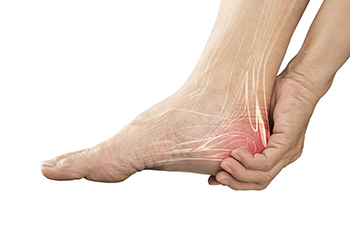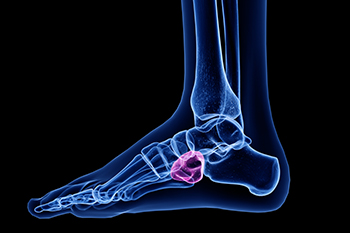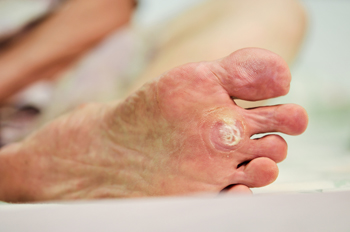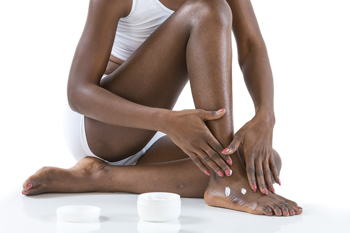August 2022
What Tarsal Tunnel Syndrome Feels Like

Certain afflictions of the foot that can hinder the health of your feet involve the nerves. Tarsal tunnel syndrome is one such condition. An individual can develop this affliction when the nerve that runs through the tarsal tunnel becomes compressed. The tarsal tunnel is found near the Achilles tendon, and the affected nerve is known as the tibial nerve. This nerve can become compressed in the tarsal tunnel for a variety of reasons. Most commonly, compression is due to an injury or stress over a prolonged period of time. Those who suffer from tarsal tunnel syndrome can experience a wide range of symptoms. For example, a patient might notice painful sensations that can reach well into the foot’s arch. Additionally, those with tarsal tunnel syndrome can experience a feeling of numbness, especially in the bottom of the feet, known as the soles. Swelling is also another common symptom of this foot condition. Pain caused by tarsal tunnel syndrome can sometimes make it more difficult to engage in physical activities such as walking and running. If you believe that you may have tarsal tunnel syndrome, contact a podiatrist for a diagnosis.
Tarsal tunnel syndrome can be very uncomfortable to live with. If you are experiencing tarsal tunnel syndrome, contact Dr. Kirk Sherris of Liberty Bay Foot & Ankle. Our doctor can provide the care you need to keep you pain-free and on your feet.
Tarsal Tunnel Syndrome
Tarsal tunnel syndrome, which can also be called tibial nerve dysfunction, is an uncommon condition of misfiring peripheral nerves in the foot. The tibial nerve is the peripheral nerve in the leg responsible for sensation and movement of the foot and calf muscles. In tarsal tunnel syndrome, the tibial nerve is damaged, causing problems with movement and feeling in the foot of the affected leg.
Common Cause of Tarsal Tunnel Syndrome
- Involves pressure or an injury, direct pressure on the tibial nerve for an extended period of time, sometimes caused by other body structures close by or near the knee.
- Diseases that damage nerves, including diabetes, may cause tarsal tunnel syndrome.
- At times, tarsal tunnel syndrome can appear without an obvious cause in some cases.
The Effects of Tarsal Tunnel Syndrome
- Different sensations, an afflicted person may experience pain, tingling, burning or other unusual sensations in the foot of the affected leg.
- The foot muscles, toes and ankle become weaker, and curling your toes or flexing your foot can become difficult.
- If condition worsens, infections and ulcers may develop on the foot that is experiencing the syndrome.
A physical exam of the leg can help identify the presence of tarsal tunnel syndrome. Medical tests, such as a nerve biopsy, are also used to diagnose the condition. Patients may receive physical therapy and prescriptive medication. In extreme cases, some may require surgery.
If you have any questions please feel free to contact our office located in Poulsbo, WA . We offer the newest diagnostic and treatment technologies for all your foot and ankle needs.
Getting to the Root of Heel Pain

Heel pain can be caused by a variety of conditions. Plantar fasciitis is an overuse injury and the leading cause of heel pain. This is where the plantar fascia tissue on the bottom of the foot—which connects the heel bone with the toes—is overly stressed or torn, and becomes inflamed. Stress on the heel bone, caused by plantar fasciitis, can also trigger a reactionary response in the body where calcium deposits (heel spurs) build up on the heel bone over time. However, heel spurs are not always symptomatic. If a growing child experiences heel pain, they may have Sever’s disease, an inflammation of the growth plate at the back of the heel. Another type of heel pain can be caused by irritation and inflammation of the fluid-filled sac (bursa) at the back of the ankle where the heel connects with the Achilles tendon. This is known as bursitis. Heel pain can also be caused by a nerve leading to the heel that becomes compressed, bumps and bruises, and even systemic diseases like gout and arthritis. If you are experiencing any kind of heel pain, have your condition properly diagnosed and treated by a podiatrist.
Many people suffer from bouts of heel pain. For more information, contact Dr. Kirk Sherris of Liberty Bay Foot & Ankle. Our doctor can provide the care you need to keep you pain-free and on your feet.
Causes of Heel Pain
Heel pain is often associated with plantar fasciitis. The plantar fascia is a band of tissues that extends along the bottom of the foot. A rip or tear in this ligament can cause inflammation of the tissue.
Achilles tendonitis is another cause of heel pain. Inflammation of the Achilles tendon will cause pain from fractures and muscle tearing. Lack of flexibility is also another symptom.
Heel spurs are another cause of pain. When the tissues of the plantar fascia undergo a great deal of stress, it can lead to ligament separation from the heel bone, causing heel spurs.
Why Might Heel Pain Occur?
- Wearing ill-fitting shoes
- Wearing non-supportive shoes
- Weight change
- Excessive running
Treatments
Heel pain should be treated as soon as possible for immediate results. Keeping your feet in a stress-free environment will help. If you suffer from Achilles tendonitis or plantar fasciitis, applying ice will reduce the swelling. Stretching before an exercise like running will help the muscles. Using all these tips will help make heel pain a condition of the past.
If you have any questions please contact our office located in Poulsbo, WA . We offer the newest diagnostic and treatment technologies for all your foot and ankle needs.
Where is the Cuboid Bone Located?

The cuboid bone is located in the foot, and cuboid syndrome can occur when the surrounding joints and ligaments become inflamed. The pain is often felt on the outside of the foot where the pinky toe is, and may increase when weight is put on it. It can happen as a result of the cuboid bone moving outward as the heel bone moves inward, often from a sprain. Some people experience cuboid syndrome by putting repetitive strain on the foot while participating in running and jumping activities. There may be existing medical conditions that can lead to developing this condition. These include having flat feet or being obese. Additionally, having gout, arthritis and certain bone conditions may lead to getting cuboid syndrome. Effective preventive methods can include stretching the foot adequately before beginning an exercise routine, and it can be beneficial to wear shoes that have ample support. Treatment can begin with elevating the affected foot, and specific stretches and exercises can be done that can help to minimize discomfort. If you have this type of pain in your foot, please consult with a podiatrist as quickly as possible who can properly diagnose and treat this ailment.
Cuboid syndrome, also known as cuboid subluxation, occurs when the joints and ligaments near the cuboid bone in the foot become torn. If you have cuboid syndrome, consult with Dr. Kirk Sherris from Liberty Bay Foot & Ankle. Our doctor will assess your condition and provide you with quality foot and ankle treatment.
Cuboid syndrome is a common cause of lateral foot pain, which is pain on the outside of the foot. The condition may happen suddenly due to an ankle sprain, or it may develop slowly overtime from repetitive tension through the bone and surrounding structures.
Causes
The most common causes of cuboid syndrome include:
- Injury – The most common cause of this ailment is an ankle sprain.
- Repetitive Strain – Tension placed through the peroneus longus muscle from repetitive activities such as jumping and running may cause excessive traction on the bone causing it to sublux.
- Altered Foot Biomechanics – Most people suffering from cuboid subluxation have flat feet.
Symptoms
A common symptom of cuboid syndrome is pain along the outside of the foot which can be felt in the ankle and toes. This pain may create walking difficulties and may cause those with the condition to walk with a limp.
Diagnosis
Diagnosis of cuboid syndrome is often difficult, and it is often misdiagnosed. X-rays, MRIs and CT scans often fail to properly show the cuboid subluxation. Although there isn’t a specific test used to diagnose cuboid syndrome, your podiatrist will usually check if pain is felt while pressing firmly on the cuboid bone of your foot.
Treatment
Just as the range of causes varies widely, so do treatments. Some more common treatments are ice therapy, rest, exercise, taping, and orthotics.
If you have any questions, please feel free to contact our office located in Poulsbo, WA . We offer the newest diagnostic and treatment technologies for all your foot care needs.
Are You Suffering From Ingrown Toenails?
When Plantar Warts Are Painful

Plantar warts are small patches of hardened growths that can form on the bottom, or sole, of someone’s feet. These warts are spread from one person to another through the human papillomavirus (HPV). Importantly, plantar warts are significantly different from corns, which form on the top of toes in response to friction or stress. Many cases of plantar warts may not cause the patient any pain. However, there are instances in which warts might be painful. If you have a larger plantar wart that essentially splits open, this could be a sign that pain might be felt later. This is because the tissue underneath a larger plantar wart can become irritated, which might ultimately result in bleeding and pain. Additionally, plantar warts can also cause the patient pain depending on where they are located. Warts that are situated on the skin folds of the toes can be especially painful. If a wart is growing inward, typically in response to the body putting pressure on the bottoms of feet when standing, then this can also be particularly painful. Contact a podiatrist for help with your plantar warts.
Plantar warts can be very uncomfortable. If you need your feet checked, contact Dr. Kirk Sherris from Liberty Bay Foot & Ankle. Our doctor will assist you with all of your foot and ankle needs.
About Plantar Warts
Plantar warts are the result of HPV, or human papillomavirus, getting into open wounds on the feet. They are mostly found on the heels or balls of the feet.
While plantar warts are generally harmless, those experiencing excessive pain or those suffering from diabetes or a compromised immune system require immediate medical care. Plantar warts are easily diagnosed, usually through scraping off a bit of rough skin or by getting a biopsy.
Symptoms
- Lesions on the bottom of your feet, usually rough and grainy
- Hard or thick callused spots
- Wart seeds, which are small clotted blood vessels that look like little black spots
- Pain, discomfort, or tenderness of your feet when walking or standing
Treatment
- Freezing
- Electric tool removal
- Laser Treatment
- Topical Creams (prescription only)
- Over-the-counter medications
To help prevent developing plantar warts, avoid walking barefoot over abrasive surfaces that can cause cuts or wounds for HPV to get into. Avoiding direct contact with other warts, as well as not picking or rubbing existing warts, can help prevent the further spread of plantar warts. However, if you think you have developed plantar warts, speak to your podiatrist. He or she can diagnose the warts on your feet and recommend the appropriate treatment options.
If you have any questions please feel free to contact our office located in Poulsbo, WA . We offer the newest diagnostic and treatment technologies for all your foot and ankle needs.
Taking Care of Your Feet Every Day

We often take our feet for granted until they start hurting. Given how much we depend on our feet to get us through life, they are too important to overlook. Feet have about 26 bones and a complex network of muscles, tendons, and ligaments. They absorb the full impact of our body weight with every step we take and keep us balanced, upright, and mobile. Virtually everyone experiences foot problems in their lifetime – from foot odor, cracked heels, fallen arches, corns, to ingrown toenails, and fractures. Some of these problems can be avoided by practicing a good daily foot care routine that will help keep the skin, bones, and muscles of the feet functioning well. If necessary, use arch support inserts in shoes to keep your feet in the proper position to support your weight when you walk and provide more cushioning to the shoe. Wash, dry, and moisturize your feet daily, so that moisture and sweat do not build up and cause bacteria to grow or skin problems to develop. Wear socks made of cotton or wool to protect your feet from wear and tear, and to absorb and wick away moisture. This can also provide extra shock absorption. Note that if you are an athlete, you might want to wear high performance socks when engaging in your sport that are made of synthetic materials and are better at protecting feet from moisture. If you would like more information about how to properly care for your feet, consult with a podiatrist who can answer questions, diagnose, and treat foot and ankle problems.
Everyday foot care is very important to prevent infection and other foot ailments. If you need your feet checked, contact Dr. Kirk Sherris from Liberty Bay Foot & Ankle. Our doctor can provide the care you need to keep you pain-free and on your feet.
Everyday Foot Care
Often, people take care of their bodies, face and hair more so than they do for their feet. But the feet are a very important aspect of our bodies, and one that we should pay more attention to. Without our feet, we would not be able to perform most daily tasks.
It is best to check your feet regularly to make sure there are no new bruises or cuts that you may not have noticed before. For dry feet, moisturizer can easily be a remedy and can be applied as often as necessary to the affected areas. Wearing shoes that fit well can also help you maintain good foot health, as well as making it easier to walk and do daily activities without the stress or pain of ill-fitting shoes, high heels, or even flip flops. Wearing clean socks with closed shoes is important to ensure that sweat and bacteria do not accumulate within the shoe. Clean socks help to prevent Athlete’s foot, fungi problems, bad odors, and can absorb sweat.
If you have any questions please feel free to contact our office located in Poulsbo, WA . We offer the newest diagnostic and treatment technologies for all your foot and ankle needs.
Blog Archives
- April 2025
- March 2025
- February 2025
- January 2025
- December 2024
- November 2024
- October 2024
- September 2024
- August 2024
- July 2024
- June 2024
- May 2024
- April 2024
- March 2024
- February 2024
- January 2024
- December 2023
- November 2023
- October 2023
- September 2023
- August 2023
- July 2023
- June 2023
- May 2023
- April 2023
- March 2023
- February 2023
- January 2023
- December 2022
- November 2022
- October 2022
- September 2022
- August 2022
- July 2022
- June 2022
- May 2022
- April 2022
- March 2022
- February 2022
- January 2022
- December 2021
- November 2021
- October 2021
- September 2021
- August 2021
- July 2021
- June 2021
- May 2021
- April 2021
- March 2021
- February 2021
- January 2021
- December 2020
- November 2020
- October 2020
- September 2020
- August 2020
- July 2020
- June 2020
- May 2020
- April 2020
- March 2020
- February 2020
- January 2020
- December 2019
- November 2019
- October 2019
- September 2019
- August 2019
- July 2019
- June 2019
- May 2019
- April 2019
- March 2019
- February 2019






